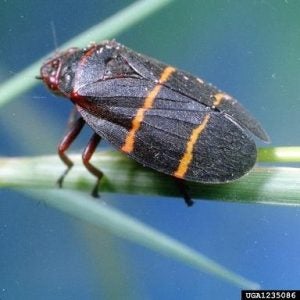Two-Lined Spittlebugs in Turfgrass
Published 4:38 pm Friday, June 2, 2017
The two-lined spittlebug is an increasingly common pest of Georgia turf grasses. It will feed on all turfgrasses, but it hits centipede turf especially hard.
Adult two-lined spittlebugs are about a quarter-inch long and black to dark brown. They have two bright, red or orange lines across their wings. Nymphs closely resemble the adults but will be white to yellowish orange with red eyes, a brown head and be wingless.
Nymphs are generally easy to spot when walking around the yard since they typically cover themselves with a white, frothy mass that resembles spittle.
This protects them from natural enemies and also prevents them from drying out.
Adults are not so easy to spot since they are fairly mobile and will fly when disturbed. Fortunately they are pretty easy to distinguish from most other insects by the distinctive two lines on their sides. Many times when infestations get heavy there will be adults lying on the belly of your lawn mower when you finish cutting your grass.
Both adults and nymphs feed on the plants by inserting their needle-like beaks into the stem and sucking out the juices. This causes the grass to yellow, wither and die if it goes unchecked.
The symptoms are similar to the damage caused by chinch bugs. But spittlebug adults are much more mobile. The damage tends to be spread out, rather than concentrated.
Spittlebugs overwinter as eggs in plant stems, under leaf sheaths or in plant debris.
Nymphs hatch in the spring and begin feeding while exuding the white, frothy mass I mentioned earlier.
The nymphs feed for about a month before becoming adults. Adults live for about three weeks and lay eggs for the last two weeks of that time. The eggs take two weeks to hatch in the summer. There are usually two spittlebug generations each year.
Early damage symptoms will look like yellow spots of dead or dying grass. With heavy infestations, these spots may overlap to form large areas of dead turf.
It’s been reported that spittlebug adults can damage a variety of ornamental plants, too, particularly during late summer and fall, when populations are at their highest levels.
The ornamental plants they prefer include hollies, asters and morning glory.
Spittlebug infestations can be controlled with several commonly available turf insecticides. Use plenty of water to apply the insecticide.
This volume is easily achieved with a hose-end sprayer, but not with a hydraulic sprayer pulled behind a lawn tractor.
Take steps to reduce the buildup of thatch. Nymphs need high humidity to survive. Turf with excessive thatch is much more likely to provide them the conditions they need.
Following good turf management practices, too, can make infestations or reinfestations less likely.
If you have any additional questions, please call The Extension Office (229-248-3033).






